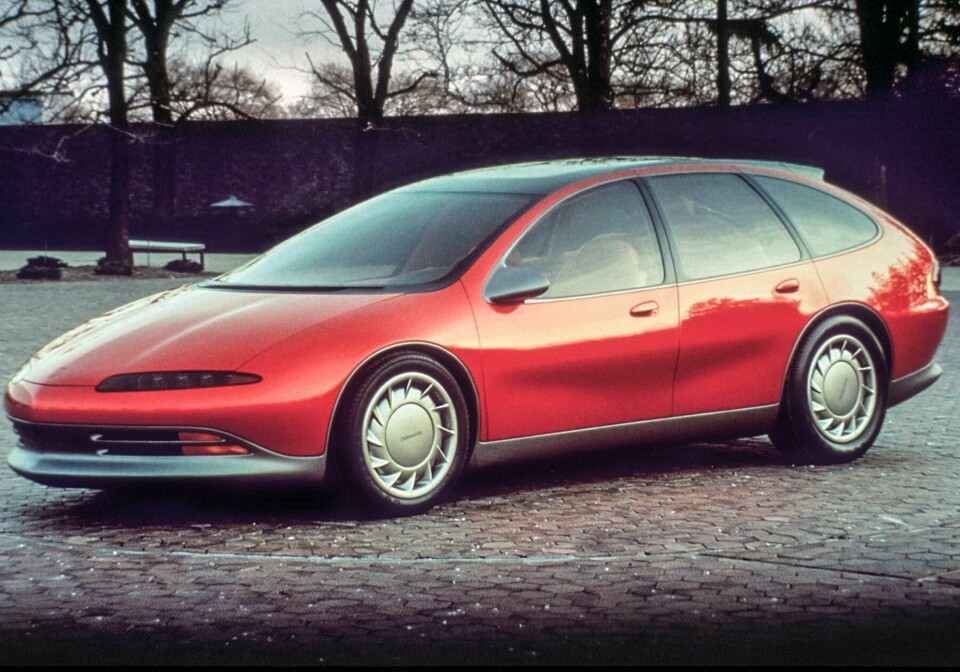
Concept Car of the Week: Oldsmobile Expression (1990)
The concept that aimed to revive the estate car with the help of a built-in Nintendo – the Oldsmobile Expression
In a stroke of curious timing, Oldsmobile introduced the Expression concept at the 1990 Detroit auto show, just months after its Silhouette minivan hit showroom floors. The latter car joined the rapidly growing trend in the US for vans that had relegated estate cars from default family haulers in the 1970s, to almost obsolete over the course of a decade.

Press ad for the ‘dustbuster’ Oldsmobile Silhouette
For that reason, the Expression was presented as a sports sedan, but to attendees and the automotive press, there was no hiding the fact that the concept was a vision of what an estate wagon reinvented for the ’90s could be.
The Expression was a futuristic, luxurious family car that combined exciting, advanced technologies with workaday utility. Such was the nature of the car’s low, shark-like nose and its bulbous passenger compartment, the concept was almost a monovolume, referencing the growing minivan trend.

At over five metres in length, and almost two metres wide, the size recalled the huge Oldsmobile Vista Cruiser of the 1970s. Originally sketched with angular lower cladding, the Expression’s surfacing is very clean and simple, with the bumpers blended into the car’s body, which was made of fibreglass, and the nose only really broken up by lamp clusters that housed five individual lamps each. To enhance the lean-forward look, the concept had 17-inch front and 18-inch rear wheels.

Press ad for the Oldsmobile Vista Cruiser
The large ovoid of the passenger compartment gave a very low beltline and very large side windows, accentuated by the blacked out B and C-pillars. In contrast to the car’s low nose, its rear overhang was huge, although the interior configuration explains why.
The traditional estate was the realm of the bench seat, which allowed for large numbers of passengers to be stuffed into the car. The Expression took a more civilised approach. The main cabin had four leather seats separated by a centre console. Airline-style indirect lighting illuminated the cabin from above, while each seat had its own reading light, creating the feel of four individual passenger compartments.

The third row featured a pair of rear-facing seats – not unusual in an American wagon – but the leather appointments, certainly represented unprecedented luxury. The rear seats were accessed through the side-hinged tailgate, while the glass portion lifted up. This doubled as an entertainment centre, with a VCR and first-generation Nintendo Entertainment System built into the tailgate itself. Hot and cold storage bins were also located in the tailgate for (almost) endless snacking. An on-board vacuum system stood by for the inevitable clean-up at day’s end.

Up front, as the parents luxuriated in the best of the leather seating. The IP design was relatively clean, with most switches moved to the steering wheel or small centre console. There was still plenty of technology, however, including a heads-up display, a navigation system complete with an early on-board screen (CRT, not touchscreen), and a hands-free cell phone.

The Expression was ultimately destined to remain a concept, as the estate wagon format lost out to the minivan. Ford did cause a brief buzz around the wagon with its radical second-generation Taurus, launched in 1995, that featured a curvaceous, ovoid design, but sadly that would remain a blip as the minivan took over.
Minivans across the industry hit their peak sales in the year 2000, and have now been gradually replaced by SUVs and crossovers. However, the Expression is an intriguing sidebar in the great automotive circle of life. Just as the wagon was usurped by the minivan as the family car of choice, so that too has since been overtaken by the crossover. However, with cars like Tesla’s Model X, which blend wagon, van and crossover to intriguing effect, there’s something about the Oldsmobile concept’s combination of form and function that could see a rebirth come the autonomous age.




